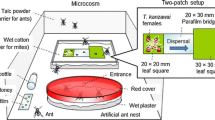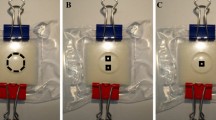Summary
Dispersal behaviour was studied on a predacious phytoseiid mite,Phytoseiulus persimilis Athias-Henriot in response to the density of its prey,Tetranychus kanzawai Kishida. And the effect of the change in the rate of successful dispersal of the predators among patches was tested on the persistence of the predator-prey system. The results of the study are summarized as follows:
-
1.
With a severe decline in prey density available per individual predator, the predators exhibited a marked behavioural change and dispersed to other areas.
-
2.
When two neighboring host plants did not touch with each other and the dispersal of the predators was possible only through a 20cm plywood “bridge” which connected the two plants, the rate of successful dispersal of the predators was only 20 to 25%, whereas it was 95% when the plants touched with each other.
-
3.
In the system where 32 host plants touched with each other, the predators succeeded in immigrating into all the plants by the 16th day, and they completely eliminated all the prey by the 33rd day.
-
4.
In another system, the 32 plants were equally divided into eight “patches” which were connected with each other with two of the bridges and the predators could move between them only through the bridges as mentioned above. In such a system the predators and their prey coexisted about three times longer than in the other one.
-
5.
It is suggested that for a longer continued coexistence of the predators and prey, it would be necessary to introduce more physical barrier against the dispersal of the predators and to provide more chances for the prey to disperse.
Similar content being viewed by others
Bibliography
Hassell, M.P. andR.M. May (1973) Stability in insect host-parasite models.J. Anim. Ecol. 42: 693–726.
Huffaker, C.B. (1958) Experimental studies on predation. II. Dispersion factors and predatorprey oscillations.Hilgardia 27: 343–383.
Huffaker, C.B., M. van de Vrie andJ.A. McMurtry (1970) Ecology of tetranychid mites and their natural enemies: A review. II. Tetranychid populations and their possible control by predator: An evaluation.Hilgardia 40: 391–458.
Iwao, S. (1968) A new regression method for analyzing the aggregation pattern in animal populations.Res. Popul. Ecol. 10: 1–20.
Luckinbill, L.S. (1973) Coexistence in laboratory populations ofParamecium aurelia and its predatorDidinium nasutum.Ecology 54: 1320–1327.
Maynard-Smith, J. (1974)Models in Ecology. Cambridge University Press, London.
Mori, H. (1975) Biological control of tetranychid mites by the predacious mite,Phytoseiulus persimilis Athias-Henriot (Acarina: Phytoseiidae). In JIBP Synthesis 7: Approaches to biological control.Yasumatsu, K. andH. Mori, eds. pp. 39–46.
Murdoch, W.W. andA. Oaten (1975) Predation and population stability.Adv. Ecol. Res. 9: 1–131.
Royama, T. (1970) Factors governing the hunting behavior and selection of food by the great tit (Parus major L.).J. Anim. Ecol. 39: 619–659.
Takafuji, A. andD.A. Chant (1976) Comparative studies of two species of predacious phytoseiid mites (Acarina: Phytoseiidae), with special reference to their responses to the density of their prey.Res. Popul. Ecol. 17: 255–310.
Author information
Authors and Affiliations
Rights and permissions
About this article
Cite this article
Takafuji, A. The effect of the rate of successful dispersal of a Phytoseiid mite,Phytoseiulus persimilis Athias-Henriot (Acarina: Phytoseiidae) on the persistence in the interactive system between the predator and its prey. Res Popul Ecol 18, 210–222 (1976). https://doi.org/10.1007/BF02754094
Issue Date:
DOI: https://doi.org/10.1007/BF02754094




